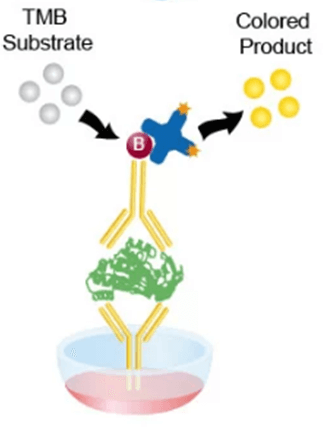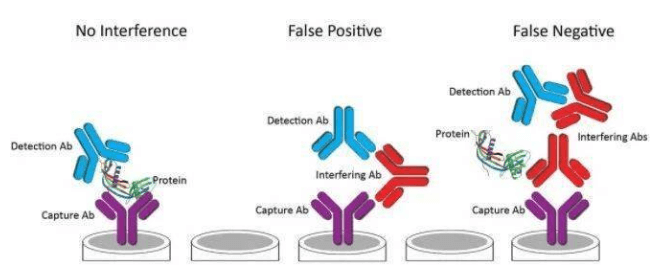Abstract: Enzyme-linked immunosorbent assay(ELISA) refers to the immune reaction by absorbing soluble antigens or antibodies to solid carriers like polystyrene and allows for the qualitative and quantitative determination of trace substances in liquid biological samples. Selection of suitable Elisa kit can facilitate the immunoassay and obtain satisfied ELISA results.
Keywords: Suitable Elisa Kit, Immunoassay, Immunology
1. Elisa Assay Principle
1) Make the antigen/antibody bound on the surface of solid carriers and keep the immunologic activity.
2) Make the antigen/antibody linked with some enzymes to form enzyme-labelled antigen/antibody which can keep immunologic and enzymatic activity. The sample and enzyme-labelled antigen/antibody react with antigen/antibody on the surface of solid carriers according to different assay steps. Separate the antigen-antibody complex from other substances by washing. Enzyme amount bound on the surface of solid carriers is proportional to analyte amount in the sample. The added TMB substrate is catalyzed and converted to coloured product by the enzyme. Thus, the qualitative or quantitative analysis can be performed according to colour depth.

2. Selection of Suitable Elisa Kit
Elisa test is featured in high sensitivity and specificity, simple operation, small sample size etc. Since the detection result is accurate and reproducible, ELISA is widely applied in detection of antigen, antibody and pathogen. Currently, there are various Elisa kits in the market. Selection guide is specified below.
First, the experimental purpose for target function or content detection should be determined. Functional detection usually refers to the enzyme-substrate reaction and bioactivity analysis. ELISA is especially suitable for the detection of target molecule amount.
Then, for analytes like protein or polypeptide, the equivalent ID can be checked in Uniprot database. During searching for your product, enter the Uniprot ID and detection target. For analytes like small molecule hapten, the equivalent CAS Number can be checked in ChemSpider database. Choose the product according to CAS Number.
Thus, we need to check the existence and relevant content range of the detection target in the biological sample. Choose an Elisa kit with enough sensitivity and confirm whether the sample type is included in the kit.
3. Comparisons among Different Elisa Kits
If Elisa kits from different vendors are available, comparisons among sensitivity, specificity, precision, recovery, linearity, stability and natural sample data are suggested. These features can show the validity and credibility, since ELISA is a manually established microanalysis method.
3.1. Sensitivity
Sensitivity is the minimum detection ability for the analyte. If the concentration of the analyte is very low, a high sensitivity Elisa kit can be chosen. The sensitivity equates to three times the standard deviation of the concentration corresponding to the blank.
3.2. Specificity
Specificity judges the binding ability of other molecules to antibodies in this kit. Lower cross reaction shows higher specificity. Furthermore, cross reaction between the Elisa kit and homologous proteins, proteins from other species, common factors in serum(e.g. heterophilic antibody, rheumatoid factor etc), interacting proteins should be measured.

3.3. Precision
Precision is also called reproducibility which evaluates errors of repeated assay for the same sample. Usually, Intra or Inter-Assay CV should be below 10%. FineTest Elisa kit is produced by automatic machines to remove manual instability and strictly controls Intra or Inter-Assay CV. E.g. Electronic pipettor and automatic coating machine contributes to precise sample loading.
3.4. Recovery
Recovery is usually measured by spike-in. The qualified recovery is between 80%-120%. Add standards into natural sample matrix to measure. Natural sample matrix without standards is the control group. Recovery is the ratio between measured concentration of analyte and the concentration of added standards. Higher or lower recovery will result in false positive or negative and affects the accuracy of measured value.
| Matrix | Recovery Range(%) | Average(%) |
| Serum(n=5) | 85-98 | 93 |
| EDTA Plasma(n=5) | 88-100 | 95 |
| Heparin Plasma(n=5) | 86-98 | 93 |
3.5. Linearity
Add proper concentration of standards into natural sample matrix and dilute at 1:2, 1:4 and 1:8 respectively. Then, measure the recovery at different concentration. 80%-120% recovery is acceptable.
| Sample | 1:2 | 1:4 | 1:8 |
| Serum(n=5) | 82-98% | 84-100% | 82-100% |
| EDTA Plasma(n=5) | 80-104% | 90-102% | 86-97% |
| Heparin Plasma(n=5) | 82-95% | 83-98% | 84-100% |
3.6. Stability
Stability is usually validated by accelerated destructive test. Place the sealed Elisa kit at 37℃ and 2-8℃ for a while respectively to check the performance. The deviation should be within 10%. The high stability keeps the Elisa kit stored for a longer time.
3.7. Detection for Natural Samples
Finally, the Elisa kit can detect natural samples and relevant sample types. Judge the suitable sample according to the feature of analyte and detect a minimum of 5 samples. Provide some sample data to customers for reference.
REFERENCES
An ELISA protocol to improve the accuracy and reliability of serological antibody assays, PMID: 28417081.
